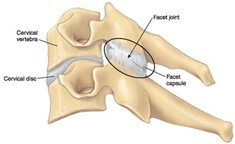The facet joints of the lumbar spine also know as the apophyseal joints, they allow the spine to move in three different planes; forward and backward, tilting to the side and rotation. There are 25 pairs of facet joints throughout the entire spinal column. The facet joint is a synovial joint consisting of two articular surfaces from the vertebrae above and the vertebrae below which meet to form the joint. The facet joint surface is composed of articular cartilage which is joined by a fibrous capsule and reinforced with ligaments. Paraspinal muscles cover the facet joints and contraction causes movement to occur.
The facet joints like other synovial joints can be injured and sprains can occur. This involves overstretching of the joint and in the lumbar spine results in localised one-sided low back pain. There may be associated spasm of the para-spinal muscles and pain is often re-produced with arching backwards or tilting to the painful side. There can referred buttock or thigh pain in severe cases. Research has shown manual therapy is effective in treating this condition.
Lumbar spine facet joints commonly become arthritic. This is most common in the lower two spinal segments, L4/5 and L5/s1 where there is significant spinal loading. This results in pain and stiffness often causing restriction of spinal movement, especially with arching backwards and side tilting. Manual therapy and a low impact exercise regime are effective in managing this condition. Hydrotherapy is another low-impact form of exercise that can be beneficial in treating this condition.
In severe cases arthritic facet joints can form a synovial cyst. This can result in impingement of the exiting nerve root and cause ‘sciatic’ leg pain. Steroid injections can he helpful in most cases. Surgery may be indicated for those cases non-responsive to a CT guided nerve root injection.
Physiotherapy focusses on a combination of manual therapy and soft tissue releases to restore normal movement of the facet joint. Certain techniques such mobilisation or manipulation are used which combined with a home exercise programme normalises spinal movement. Postural re-training may be used to reduce the compressive loading across the facet joints. Lumbar spine muscle re-training and strengthening may be used to provide improved stability of the injured facet joint.

